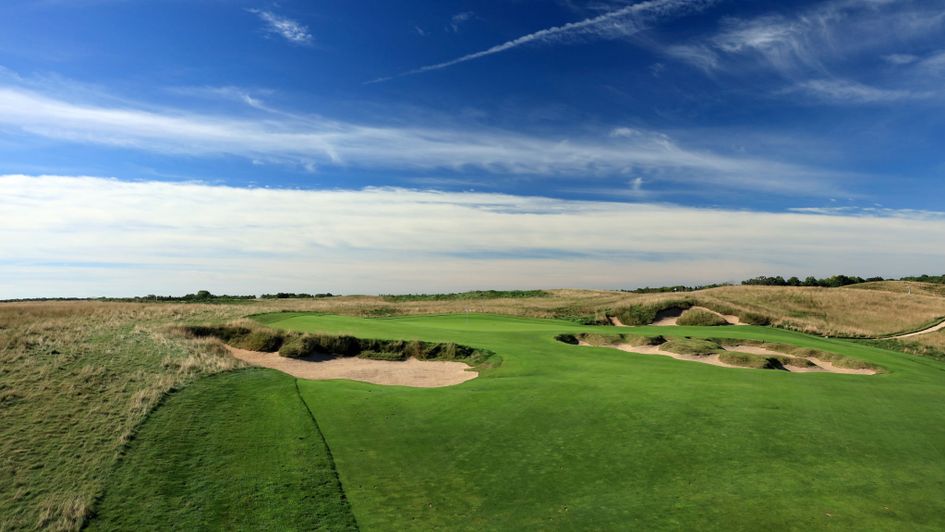Find out why there's scare stories surrounding the venue of this year's US Open with our hole-by-hole course guide of Erin Hills.
David John's outright betting tips
David John's US Open specials
David John's round one preview
US Open tee times
Profiles & odds for the leading contenders
Sky Bet paying 8 places: Outsiders to follow
Although they always deny it, the United States Golf Association (USGA) want the US Open to be the toughest test for the world's best players, with the winning score close to level par.
That usually means narrow fairways, thick rough and quick greens and Erin Hills in Wisconsin looks to be no exception, with scare stories abounding about the knee-high fescue grass which lurks just a few feet off the fairways.
One of the favourites, Jon Rahm, who has also been selected by our tipster David John, has even branded it like a "links course on steroids"!
So without further ado, here is our hole-by-hole guide of Erin Hills...
1st, 560 yards, par 5: A relatively easy opening hole, although the shortest route to the green requires a drive close to the wetlands to the left of the fairway. The small green slopes gently from front to back.
2nd, 338 yards, par 4: The shortest par four could be driveable in favourable conditions, although the green is the smallest on the course and slopes from front to back. Large mounds on either side of the fairway block the view of the landing area for those adopting a more conservative approach.
3rd, 508 yards, par 4: The easy start ends here with the longest par four on the front nine, made more difficult by being played into the prevailing wind. Bunkers on either side protect a fairway which slopes significantly from right to left, while the two-tiered green demands an accurate second shot.
4th, 439 yards, par 4: A driver may not be required from the elevated tee, with a premium placed on avoiding the fairway bunkers in order to set up a second shot which will need to be well judged to find the shallow green.
5th, 505 yards, par 4: Only three yards shorter than the third, but plays downwind and features a generous green with a backstop on the left that can be used to feed a shot towards the flag.
6th, 208 yards, par 3: The longest par three on the course also has the longest green (48 yards), which slopes largely from front to back. However, a false front will funnel anything short away from the green.
7th, 607 yards, par 5: Fourteen bunkers mean accuracy is as important as length on this par five, with several just short of the putting surface making for a difficult approach to a green divided by a prominent ridge.
8th, 492 yards, par 4: Arguably the toughest tee shot on the course is played partially blind to a fairway which slopes from left to right while it doglegs from right to left. Three deep bunkers will collect any uphill approach coming up short of the green, which has a useful backstop on the left-hand side.
9th, 135 yards, par 3: The shortest hole on the course also features a drop of around 25 feet from tee to green, but the putting surface is exposed to the wind and is protected by seven deep bunkers. Not as easy as the yardage suggests.
10th, 504 yards, par 4: A difficult drive is played to a heavily contoured fairway which includes a downslope on the right that can give welcome extra distance. The shallowest green on the course is bisected by a ridge.
11th, 460 yards, par 4: A blind tee shot is made even harder by a fairway - widened since the 2011 US Amateur - which slopes from left to right. Two deep bunkers guard the front of the green, although they are further away from the putting surface than it looks.
12th, 464 yards, par 4: Only the crest of the hill can be seen from the tee, with a narrow landing area sitting between two mounds. Just one bunker protects the right-hand side of the green, but the tall fescue grass is closer to the crowned putting surface than on most other holes.
13th, 193 yards, par 3: Anything left of the green is likely to feed into a large bunker and anything right will run away down the slope and leave a difficult uphill pitch. Club selection will be vital as the green is 40 yards long.
14th, 594 yards, par 5: Longer hitters may be able to reach the green in two, although the green has a pronounced false front and severe drop-off to the right, which leads towards a small stream.
15th, 357 yards, par 4: An elevated green provides the major challenge on this short par four, with any mishit approach to the two-tier putting surface likely to be gathered by one of the deep bunkers.
16th, 183 yards, par 3: Another elevated green and a long and narrow one as well, which is guarded by deep bunkers on either side. The two-tiered putting surface also slopes from back to front.
17th, 509 yards, par 4: The only hole on the course without a bunker, but an undulating fairway can result in some uneven lies for approach shots and a large mound on the left obscures the view of the green.
18th, 637 yards, par 5: A three-shot hole for even the longest hitters, with 25 bunkers - including one in the middle of the fairway around 120 yards from the green - adding to the difficulty. A par to win in the final round will be no easy task.









